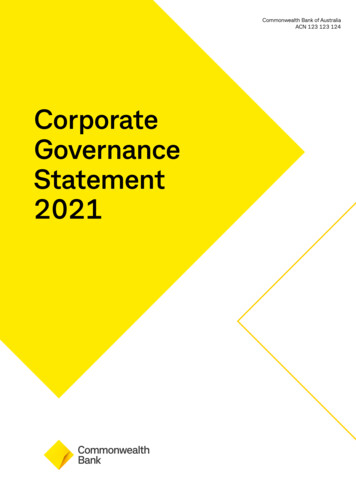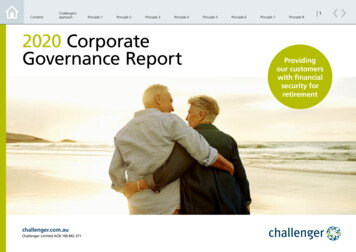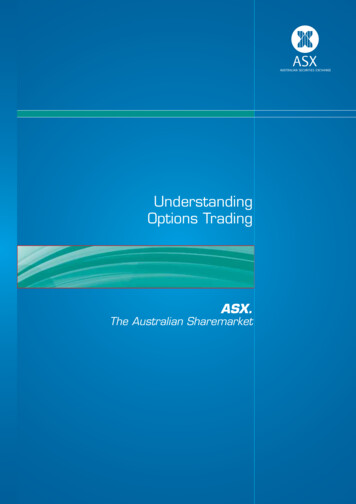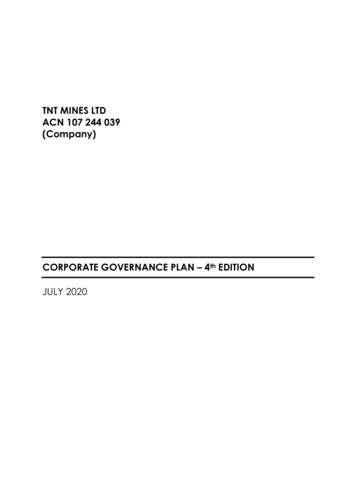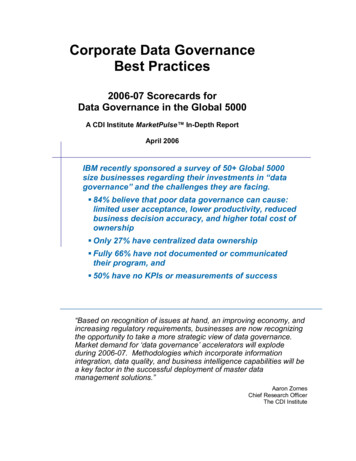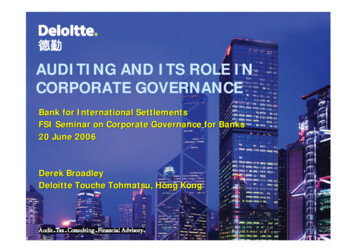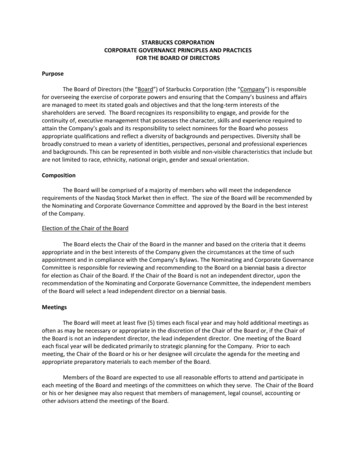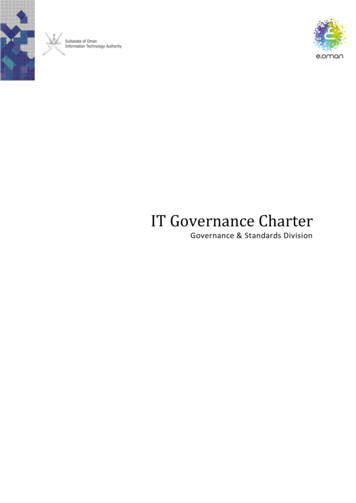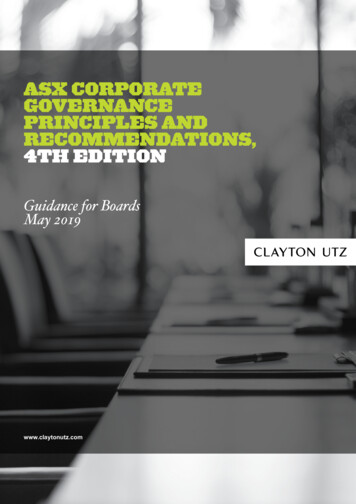
Transcription
ASX CORPORATEGOVERNANCEPRINCIPLES ANDRECOMMENDATIONS,4TH EDITIONGuidance for BoardsMay 2019www.claytonutz.com
The 4th Edition in its final form is undoubtedly cleaner and more succinct than theConsultation Draft and removes uncertainties which were inherent in that Draft, such as thosearising from the “social licence to operate” and Recommendations which potentially conflictedwith the conventional understanding of the duties and responsibilities of directors in Australia.Emerging from it are four Key Messages which will require careful deliberation by Boards: the responsibilities of the Board (Principle 1); culture and values (Principle 3); identification and management of risk (Principle 7); and remuneration (Principle 8).And not just careful consideration; they will most likely require listed entities to redrafttheir Board Charters and the charters of its committees together with their stated corporategovernance procedures. In this Guidance we analyse the 4th Edition’s impact, and the issues tobe addressed by Boards and Management when implementing the 4th Edition.The 4th Edition is not however the only part of the corporate governance puzzle for corporateAustralia. The revised Principles should be read in conjunction with the Report Commissionedby APRA in relation to the Commonwealth Bank of Australia and the Final Report of theFinancial Services Royal Commission. While we recognise that the APRA Review and theRoyal Commission dealt with entities providing financial services, it is clear that the lessonslearnt will be applied more broadly.The 4th Edition is not perfect; we have identified some missed opportunities and areas forfuture clarification and discussion that will no doubt form part of the ongoing conversation oncorporate governance in Australia. However, overall the ASX Corporate Governance Council isto be commended for the 4th Edition as published, and in particular Principles 1, 3 and 7.In conclusion, it must be remembered that the ASX Corporate Governance Principles andRecommendations were first published in 2003 as voluntary Recommendations which apply toASX-listed entities on an “if not, why not” basis, so as to forestall the sort of highly prescriptivelegislation on corporate governance that was introduced around that time in the United States.In our view it remains to be seen whether the 4th Edition alone will be adequate to meet theever increasing community expectations of corporates, given some of the challenges thatwill be faced by entities in implementing them in practice. This is particularly so with thespotlight and pressure on entities to implement non-financial metrics for long-term executiveremuneration incentives. APRA Chairman Wayne Byres, in his address at the AFR Bankingand Wealth Summit, stated that in his view, “attempts to move away from the conventionalmodel of executive remuneration have not been wholly welcomed and so it seems inevitablethat regulatory intervention and a greater degree of prescription will be required to shiftpractices”. Overall the regulatory direction we appear to be heading may become incompatiblewith the original purpose of the Principles, which was to avoid prescriptive law-making.2
PART 1: KEY MESSAGESThe 4th Edition introduces some important changes. The following are the key messages and takeaways for listedentities.Board Responsibility, Culture and Values (Principles 1 and 3)A Board Charter should delineate the respective roles of the Board and Management (Principle 1).In particular, the Charter should state that the role of the Board is to: define the entity’s purpose and set its strategic objectives; approve the entity’s statement of values and code of conduct to underpin the desired culture within theentity; satisfy itself that the entity has in place an appropriate risk management framework for both financial andnon-financial risks; set the risk appetite to which the Board expects Management to operate; and satisfy itself that the entity’s remuneration policies are aligned with the entity’s purpose, values, strategicobjectives and risk appetite.A listed entity should instil and continually reinforce a culture across the organisation of acting lawfully,ethically and responsibly (Principle 3). In particular, a listed entity should articulate and disclose its values.Articulating, socialising and measuring the culture, purpose and values of an ASX-listed entity now clearly fall to theresponsibility of the Board and should be treated with the same priority as strategy-setting and risk management. Inthe 4th Edition, we continue to observe a clear shift towards greater accountability by the Board in setting corporategovernance expectations which align with community standards.There is now an expectation that Boards will conduct a robust self-assessment on how the entity is living up to itsculture and its values, and ensure that the entity’s strategy and risk appetite are measured against culture, purposeand values. Principle 1 clearly requires these matters to be emphasised and addressed in an entity’s Board Charter.For Boards to be able to adequately discharge their duties in setting and maintaining culture, they will need to beincreasingly inquisitive of Management to ensure that the Board is receiving enough of the right information tomeasure the entity performance against its purpose and values properly. Executives should be encouraged to notsimply ask whether an activity is allowed (“can we?”) but whether it is ethical and appropriate (“should we?”). The 4thEdition is also very clear that this is an ongoing process. The rigour of compliance and self-assessment should beconstantly revisited.Similarly, reporting protocols within an organisation will need to be expanded to report up to the Board on thesematters, and any material non-compliance should be dealt with at Board level. The Commentary makes it clear thatManagement should not only provide financial information but also information about its compliance with materiallegal and regulatory requirements, including any conduct that is materially inconsistent with the entity’s values orcode of conduct. This is consistent with the expectation that an entity’s purpose is not solely to deliver financialreturns but also to ensure it operates in accordance with its values, code of conduct and the risk appetite set by theBoard.Sustainable, long-term financial return of an entity is inextricably and positively linked to its having a clear setof values and purpose – and Principles 1 and 3 clearly reflect this proposition. While there are no set criteria forwhat should constitute an entity’s purpose, it can no longer be short-term, myopic financial return. As Larry Fink,CEO of BlackRock puts it, “purpose aligns focus and strategic discipline to drive long-term profitability”. Likewisestakeholders are increasingly making decisions based on the social and ethical responsibility of entities, such aswhether to purchase a product or service or to invest in the entity. It is clear that entities are expected to considertheir purpose in line with wider corporate citizenship expectations.3
Principle 3 recognises that values are the guiding principles and norms of an entity. In formulating its values, anentity should consider what behaviours are needed from its officers and employees to achieve sustainable value forits security holders. The Board and Management of listed entities are now tasked with instilling a culture of actinglawfully, ethically and responsibly, taking into consideration a broad range of stakeholders to maintain their reputationand standing in the community. ASX-listed entities should be developing and measuring a culture of sustainability,long-term successful and stakeholder objectives. Ultimately, this shift is consistent with the sentiment playing out incorporate Australia: that executives of for-profit entities cannot keep operating with limited vision focused primarily onshort-term profits.This emerging need is already being recognised. For example, Rio Tinto PLC (a dual listed company along with RioTinto Limited) “downgraded the focus on shareholder returns in favour of spruiking the company’s commitment tosustainability” in its 2019 Annual General Meeting.1Identification and management of risk (Principle 7)A listed entity should establish a sound risk management framework and periodically review theeffectiveness of that framework (Principle 7).In particular: the entity should have a Risk Committee which should be of sufficient size and independence, and its membersbetween them should have the necessary technical knowledge and a sufficient understanding of the industry inwhich the entity operates, to be able to discharge the Committee’s mandate effectively; the Board should review the entity’s risk management framework at least annually to satisfy itself that it continuesto be sound; the Board should ensure the entity is operating with due regard to the risk appetite set by the Board; and the entity should disclose whether it has any material exposure to environmental or social risk, with particularattention to climate change, and if it does, how it manages or intends to manage those risks.Consistent with the themes in the current regulatory environment, the 4th Edition of the Principles places significantimportance on the Board’s role in identifying and managing risk. The 4th Edition changes also reflect an expansionof the roles of the Risk Committee.Composition and role of the Risk CommitteeThe composition of the Risk Committee is as important as its function. Recommendation 7.1 provides that the RiskCommittee can either be a standalone Risk Committee, a combined Audit and Risk Committee, or a combinationof board committees addressing different elements of risk. Regardless of the structure, directors who serve on theRisk Committee should have a strong understanding of the risks in the industry in which the entity operates. Withoutthe proper industry and entity knowledge they cannot properly anticipate risk and set the risk appetite for an entitythat is appropriate with the entity’s culture and values. The different Board Committees also need to ensure thatthey communicate with each other in order to avoid siloing. This issue of siloing was also raised in the Report of thePrudential Inquiry into CBA.The expansion of the role of the Risk Committee in the 4th Edition recognises that, overall, Boards need to be moreactive than they currently are in an entity’s risk management. Management is now required to report to the Board onnew and emerging sources of risk (discussed below) and have the risk controls and mitigation measures in place todeal with those risks.The Australian Business Review, "Rio pitches sustainability plan at AGM" tory/03024580b5cd6f5260db7d52c1bc363a .14
Financial and non-financial risksWhile the term “social licence to operate” in the Consultation Paper has since been removed, its themes (forexample, requiring Boards to think beyond short-term financial return and risks, including consideration of reputationand community expectation), and those of the Final Report on the Financial Services Royal Commission, are stillprevalent in the 4th Edition.The 4th Edition now expect Boards to also consider non-financial risks. There are several key changes in thisrespect, including the introduction of “social risk” in Recommendation 7.4, which relates to the risk of negativeconsequences to a listed entity if it or its activities adversely affect society. The examples given are broad andinclude risks arising from the entity or suppliers engaging in modern slavery or aiding human conflict, as well asmass migration and pandemics.The Principle recognises that contemporaneous and emerging risks are increasingly becoming a serious threat toprofitability. The Council identifies risks, such as those arising from digital disruption, cyber-security, sustainabilityand climate change. Taking climate change as an example, there is a shift in the way it is being viewed, from beingan ethical or moral issue to one that, if handled poorly, can lead to reputational, and consequently financial risk.Practice Note: The Commentary in Recommendation 7.2 contemplates that an entity might have to operate outsidethe risk appetite set by the Board; if so, the matters should be brought to the Board’s attention. A situation wherethis may arise is when an entity acquires a business division of another entity for sound commercial reasons, but itassesses the risk management of that business to be inadequate in relation to its own, and must bring it into line. Inthese circumstances, having a Board with expertise in the entity and industry will be crucial.Disclosure of material exposureThere is also focus on the requirement of disclosure where a listed entity has a material exposure to a non-financialrisk. The Principles recommend that entities benchmark their disclosure of environmental or social risk againstthat of their peers. This requires Boards to have greater regard to the impact these non-financial risks may haveon the entity. The Principles also adopt the Recommendation that listed entities with material exposure to climatechange risk must consider implementing the Recommendations of the FSB’s Task Force on Climate-relatedFinancial Disclosures.2 This reflects increasing pressures from stakeholders and interest groups to report in line withinternational standards.Practice Note: Entities, particularly big emitters, will need to be asking themselves whether there have been anyexposure to non-financial risks such as environmental, sustainability, climate change, in the relevant reporting periodin order to make the proper disclosure. This requires entities to have proper measures for identifying exposure tothese types of risk. Boards will need to continue to review their risk management frameworks at least annually toensure that they are be sound.Remuneration (Principle 8)A listed entity should remunerate its executives to attract, retain and motivate high quality senior executivesand in line with the entity’s values, culture and risk appetite in the short-, medium- and longer-term(Principle 8).In particular: remuneration is a key driver of culture and a key focus for investors; and when setting the level and composition of remuneration, a listed entity needs to balance its desire to attract andretain high-quality directors and senior executives against ensuring that the incentives encourage its growth andsuccess without rewarding conduct that is contrary to its values or risk appetite.2The Financial Stability Board's (FSB) Task Force on Climate-related Financial Disclosure is an internationally recognised bodyresponsible for developing Recommendations for voluntary climate-related financial disclosures that are consistent, comparable,reliable, clear, and efficient, and provide decision-useful information to lenders, insurers, and investors. The FSB Task Forcecomprises of 31 members from across the G20 countries. The Final Report on Recommendations on Climate-related FinancialDisclosures can be accessed here: 6/FINAL-2017-TCFD-Report-11052018.pdf .5
Key takeaways1. Executive remuneration frameworks should place a stronger emphasis on non-financial metrics in assessingexecutive performance.2. Deferring entitlement to executive remuneration incentives aligns with long-term performance.3. Malus and Clawback of remuneration provisions in long-term performance incentives are underutilised and havethe potential to play an important role in ensuring that non-financial outcomes are taken into account.Greater role of non-financial metricsThe Recommendations in Principle 8 create a challenge for entities: how should they align executive remunerationwith their values, culture and risk appetite along with financial targets in the short-, medium- and longer-term?In the Final Report of the Financial Services Royal Commission, APRA Chairman Wayne Byres criticised the currentstructure of long-term variable remuneration in Australian entities as being “out of step with how best practices inremuneration are evolving internationally”.3 In particular, he noted that Australian executive remuneration models didnot have enough focus on non-financial metrics when assessing performance hurdles for long-term incentives.The rationale is that having high-performing non-financial measures not only aligns with entity values and riskmanagement, but also drives long-term profitability. Wayne Byres also considers that Boards need to be moreaccountable in exercising discretion when assessing and rewarding executives on their performance, and calls forgreater transparency in Board decision-making and less formulaic approaches favoured by investors.4However there are concerns about how non-financial metrics can be implemented in practice. Boards have generallynot been so accommodating as to shift their practices, and the investment community is divided over promotingthe right kind of behaviour – and doubting it can be practically implemented. For example, one industry fund hasconsidered that “it will be difficult getting into the detail of what to measure and how to measure it”, with the Boardneeding to make more subjective decisions.5Similarly, it appears shareholder consensus on the matter could be difficult to obtain, given the varying opinions onthe matter held by large and small investors in the past. When presented with changing executive remunerationframeworks, shareholders have been surprisingly resistant to such a change. For example, the Commonwealth Bankof Australia attempted to do so in 2016, only to be rejected by shareholders; two years later, NAB’s similar proposalwas rejected by 88% of its shareholders.'Royal Commission into Misconduct in the Banking, Superannuation and Financial Services Industry' iles/2019-02/fsrc-volume-1-final-report.pdf at p. 353.4Wayne Byres, "The Incentive to Fly Safely", the AFR Banking & Wealth Summit 2018, Sydney tive-fly-safely .5Joanna Mather and Sally Patten, "A Seat at the Table", (April 2019) Australian Financial Review Boss Magazine 19.36
Deferral of long-term incentives, Malus and ClawbackPerhaps a way to manoeuvre the difficulties of non-financial metrics and still promote the right kind of behaviour isnot to dangle the carrot but to threaten with the stick. Entities can give effect to Principle 8 by employing policiesrelating to the deferring of entitlements to receive long-term incentives and by introducing a tighter policy aroundMalus and Clawback.The Commentary in the 4th Edition Recommendation 8.2 introduces for the first time guidance for entities to disclosetheir policies regarding the reduction, cancellation (Malus) or Clawback of performance-based remuneration in theevents of serious misconduct or material misstatement in financial statements. While this is an overall highly positiveaddition to the Principles, the Recommendation only refers to serious misconduct or material misstatement offinancial statements as situations warranting Malus or Clawback. This is unlikely to be broad enough. For example,the policy applied by ASX Limited, as disclosed in its Clawback Policy6, is that Clawback should apply “anywherewhere adverse outcomes have arisen during a performance based remuneration period that warrants a reductionor reassessment of the original assessment of performance” and if “any other circumstances occur which the Boarddetermines in good faith to have resulted in an inappropriate benefit”.7Introducing or strengthening an entity’s current Malus or Clawback practices ensure that inappropriate conduct isnot rewarded and can be a strong deterrent for misconduct, yet they are underutilised for a variety of reasons. First,some entities either do not have them or, where they have them, do not use them. Secondly, the exact details of theprovisions are often not publicly available to investors (other than a blanket statement that the Board has a discretionto adjust rewards).Recommendation 8.3 considers that a well-designed, equity-based remuneration, especially when linked to hurdlesthat are aligned to the entity’s short-, medium- and long-term performance objectives, will be highly effective.Deferring executive remuneration can help avoid short-termism or the taking of undue risks.Judging the performance of non-financial metrics in long-term incentives is not without its challenges. Given longterm incentives are intended to measure performance over a period of 3-4 years, it is not surprising that the vestingof these are traditionally based on financial outcomes.Practice Note: As discussed above, implementation of this Principle and corresponding Recommendations is likelyto provide significant challenges to ASX listed entities. The Remuneration Committees and Boards of those entitieswill need to rethink their approach to remuneration policies and practices in light of them.67ASX Limited, ASX Clawback Policy, https://www.asx.com.au/documents/about/ASX Clawback Policy Aug14.PDF.Ibid.7
PART 2: MISSED OPPORTUNITIESWe consider the following Principles and Recommendations as missed opportunities to provide leading guidance onincreasingly important and challenging issues faced by listed entities. They will require further clarification and, weexpect, will continue to be subject of ongoing discussion.Diversity (Recommendation 1.5)Recommendation 1.5 says that a listed entity should have and disclose a diversity policy, and throughits Board or a committee of the Board, set measurable objectives for achieving gender diversity in thecomposition of its Board, senior executive and workforce generally. In addition, an entity needs to makedisclosure on the measurable objectives set for that period to achieve this and the entity’s progress inachieving those objectives.The conversation about diversity and inclusion in Australia, and globally, is evolving at a steady pace. Given the 4thEdition of the Principles is expected to apply for several years, it may be a missed opportunity to accelerate diversityand inclusion in the business world. As such, we query if an entity that adopts Recommendation 1.5 will actually failto meet community expectations for diversity in 2020, given that many of the gender targets set by the Principles canbe readily achieved in the short term, and the evolving concept of diversity and inclusion.TargetsThe introduction of a gender target for Boards is a standout change in the 4th Edition. However, voluntary targetsare not new and not uncommon in both the public and private sector; indeed we know that as of 31 December2018, 29.7% of ASX200 companies had already achieved 30% female representation. The challenge is thereforeencouraging a goal of gender parity for those Boards and also encouraging all listed companies (ie. beyond theASX300 and small Boards) to improve their composition.While a 30% target has credibility as a tipping point, a 40:40:20 approach is gaining traction (40% women, 40% menand 20% flexible). The Australian Government, for example, is committed to achieving women and men each holdingat least 40% of Government Board positions, with women holding overall 50% of Government Board positions.Recommendation 1.5 makes it clear that “measurable gender objectives” are not only for senior executives, butrequired throughout the organisation’s workforce. This encourages listed entities to promote greater participationin leadership by women with operational expertise, which ultimately paves the way for their participation inManagement and Board appointment. In our view, this complements the growing pressure for entity and industryexpertise on Boards discussed in Principle 2.Beyond genderThere is a growing body of evidence on the benefits of embracing broader themes of diversity (such as culturaldiversity or sexual orientation), although the Recommendation did not venture further than gender diversity. As aresult, the Consultation Draft prompted feedback on the lack of a formal Recommendation on cultural diversity onthe Board or workplace. While some additional tweaks were made, the Council has shied away from anything moreprescriptive.A progressive approach would have been to broaden the “measurable objectives for achieving gender diversity” to“measurable objectives for achieving gender and cultural diversity”. This does not mandate cultural diversity targetsper se, but nurtures actions which will vary from entity to entity. While there is no cultural diversity regulator akinto the Workplace Gender Equality Agency (WGEA) operating in the background, several ASX listed companiesalready specifically disclose their approach to cultural diversity and offer useful insights on what activity drivesan improvement. For guidance beyond gender, helpful resources are available on websites such as those of theDiversity Council of Australia8 or the Australian Human Rights umanrights.gov.au/8
Diversity, inclusion and decision-makingRelated to this idea, it is interesting to note that the Commentary in Recommendation 1.5 touches on the roleof diversity in decision-making10, a theme indirectly flagged in the Final Report of the Financial Services RoyalCommission. In discussing the need for greater supervision of organisational culture by APRA, Commissioner Hayneendorses the FSB’s Toolkit11 to mitigate misconduct risks. The FSB identifies key cultural drivers that can underminethe effectiveness of governance frameworks, and lists lack of diversity and inclusion resulting in groupthink,lack of challenge and debate and lack of psychological safety, amongst others. In our view, there is a nexus fororganisations to explore further.Composition of the Board (Principle 2)The Board of a listed entity should be of an appropriate size and collectively have the skills, commitmentand knowledge of the entity and the industry in which it operates, to enable it to discharge its dutieseffectively and to add value (Principle 2).Board skills, commitment and expertisePrinciple 2 proposes that the Board of an ASX-listed entity should “collectively have the skills, commitment andknowledge of the entity and industry” in which it operates. The 4th Edition has added the word “collectively” whichwas largely in response to submissions by stakeholders to the Consultation Draft suggesting that the proposedwording in the Draft required all directors to have this expertise.The introduction of the concept of a Board “collectively” having the requisite skills reflects the predominant practiceof ensuring that a Board comprises of individuals with a range of relevant backgrounds, skills and diversity. However,overall the Council has missed a timely opportunity to reinforce the importance of having directors with strongexpertise about the entity and industry in which it operates.The Financial Services Royal Commission’s Interim Report had precipitated a growing concern that Boards may notbe properly performing their oversight function over Management, largely from a lack of subject-matter knowledgeor professional expertise amongst the directors. Increasingly entities are under strong pressure from investors tohave directors with industry expertise, who can bridge information gaps, better absorb industry shocks and challengeManagement where necessary.Under Recommendation 7.2 the Board is to monitor the adequacy of the entity’s risk management framework andsatisfy itself that the entity is operating in line with its risk appetite, including that the framework adequately dealswith contemporary and emerging risks. We suggest that a member of a Board is unlikely to properly perform thisfunction unless he or she has a thorough understanding of the business and industry in which it operates.Board Skills MatrixRecommendation 2.2 relating to the Board Skills Matrix is a missed opportunity to encourage Boards to criticallyevaluate their current skillsets and encourage meaningful disclosure to investors.The Consultation Draft had prescribed that Boards should:“either set out the mix of skills that the Board currently has or the mix of skills that the Board is looking toachieve in its membership.In the former, the Board Skills Matrix will usually take the form of a table listing all the skills the Boardthinks it should have and indicating the presence or absence of those skills among existing Boardmembers.It is also interesting that earlier editions of the ASX CGC Principles and Recommendations included Diversity under Principle 3:"Promote ethical and responsible decision-making".11"Strengthening Governance Frameworks to Mitigate Misconduct Risks: A Toolkit for Firms and Supervisors", http://www.fsb.org/wp-content/uploads/P200418.pdf .109
In the latter, the Board Skills Matrix is likely to be in the form of a statement rather than a table whichmakes clear that it is a description of the mix of skills the Board is looking to achieve in its membershipand not a representation of the existing skills the Board has. It should also summarise the steps theBoard is taking to acquire those skills”.This Commentary has not been adopted and instead entities are directed to the Governance Institute of Australia(GIA) Good Governance Guide fact sheet linked in a footnote. In our view, the result of this makes it difficult forentities to clearly know what a thorough assessment of the Board’s required skills might involve, which createsthe risk that entities produce a boilerplate statement about the existing skills. In our view, entities should carefullyconsider the GIA’s guidance on Board Skills disclosure.Focus on upskilling and continual professional developmentRecommendation 2.6 requires a listed ent
prevalent in the 4th Edition. The 4th Edition now expect Boards to also consider non-financial risks. There are several key changes in this respect, including the introduction of “social risk” in Recommendation 7.4, which relates to the risk of negative consequences to a listed
